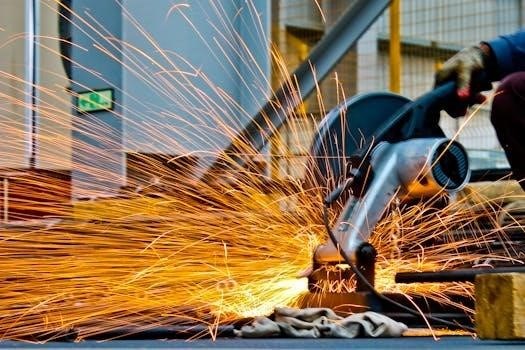Welding Textbook PDF⁚ A Comprehensive Guide
Welding Textbook PDFs offer comprehensive resources for both beginners and experienced welders. These guides often cover various welding techniques‚ metallurgical processes‚ and safety protocols‚ providing essential knowledge for successful welding projects. Free downloads are often available.
Welding is a crucial process in manufacturing and construction‚ joining materials through fusion. The physical nature of metals plays a vital role in understanding welding. Various welding techniques exist‚ each suited for specific applications. This section introduces common welding methods such as TIG welding‚ which utilizes a tungsten electrode. Understanding the basics of each technique ensures proper application and quality welds. Safety is paramount‚ requiring the correct personal protective equipment. Mastering these introductory concepts is essential for advancing in welding. Correct preparation and understanding of materials are also key to success.
Understanding Welding Processes
Welding processes involve different techniques to fuse materials. Understanding these processes‚ including TIG welding fundamentals‚ is crucial for achieving strong and reliable welds. Knowledge of each process allows for selecting the best method.
Overview of Welding Techniques
Welding techniques encompass a variety of methods‚ each suited for different materials and applications. Common techniques include TIG (Tungsten Inert Gas)‚ MIG (Metal Inert Gas)‚ stick welding‚ and flux-cored arc welding. These techniques vary in terms of equipment‚ skill required‚ and the types of metals they can effectively join. Understanding the nuances of each technique is essential for achieving strong‚ durable‚ and aesthetically pleasing welds. Factors such as heat input‚ filler metal selection‚ and shielding gas are also critical considerations. Proper technique selection ensures optimal weld quality and minimizes potential defects.
TIG Welding Fundamentals
TIG welding‚ also known as Gas Tungsten Arc Welding (GTAW)‚ is a precise welding process using a non-consumable tungsten electrode to produce the weld. An inert gas‚ typically argon‚ shields the weld area from atmospheric contamination. TIG welding is known for creating high-quality‚ clean welds‚ often free of slag. It allows for precise control over heat input‚ making it suitable for welding thin materials and dissimilar metals. Skilled operators can achieve exceptional weld appearance and structural integrity. TIG welding is frequently used in aerospace‚ automotive‚ and other industries requiring high-precision welds.
Free Resources for Welding Education
Access free welding education resources‚ including PDF downloads of welding books and materials available on platforms like the Internet Archive. Explore library resources and online materials to enhance your welding knowledge.
Free PDF Downloads of Welding Books
Discover a wealth of knowledge through free PDF downloads of comprehensive welding books. These resources offer detailed insights into various welding techniques‚ metallurgy‚ and safety practices. Many online platforms provide access to these materials‚ allowing welders of all skill levels to enhance their understanding. These digital books often cover topics like TIG welding fundamentals‚ welding design‚ and fabrication‚ and modern welding practices. Ensure you have Acrobat Reader to access these PDFs. Benefit from the convenience of having vital welding information readily available for study and reference‚ supporting continuous learning and professional development in the welding field.
Welding Books on the Internet Archive
The Internet Archive offers a treasure trove of welding books for free. This digital library provides access to a vast collection of resources‚ including historical texts and technical manuals‚ perfect for welding enthusiasts and professionals. Explore different welding techniques‚ design principles‚ and metallurgy concepts through these readily available books. The archive’s collection includes materials suitable for various skill levels‚ from beginners to advanced practitioners. You can find valuable information on topics ranging from basic welding processes to specialized applications. Take advantage of this free resource to expand your welding knowledge and enhance your expertise by exploring the extensive selection available.
Library Resources for Welding Information
Local libraries are invaluable resources for obtaining welding information. Many libraries offer access to a wide range of welding books‚ manuals‚ and periodicals. Library cards often grant free access to online databases and digital resources related to welding. These may include e-books‚ research papers‚ and technical articles from professional organizations. Furthermore‚ libraries frequently provide access to resources like Kanopy‚ allowing users to stream educational content‚ including documentaries and instructional videos on welding techniques. Librarians can assist in locating specific welding materials and offer guidance on research strategies. Utilizing library resources is an affordable and effective way to enhance welding knowledge and skills.
Key Components of Welding
Successful welding relies on essential components⁚ filler metals for strong joints‚ shielding gas to prevent contamination‚ and proper equipment maintenance. Understanding these elements ensures consistent‚ high-quality welds in various applications.
Filler Metal Solutions
Filler metals‚ whether alloys or unalloyed metals‚ are crucial for creating strong brazed or soldered joints. When melted‚ they flow into the space between close-fitting parts‚ forming a bond. Selecting the right filler metal is essential for weld quality. Consistent‚ high-quality welds are key to success in home and manufacturing applications.
Filler metals can be used in a welding environment to fill gaps between the metal and to help the weld to be stronger. The correct filler metal will help make the welding job easier and will help make the weld be more efficient.

Modern Welding Practices
Modern welding practices incorporate advanced techniques and technologies to improve efficiency and weld quality. Resources like the “Modern Welding” 12th Edition provide updated information on current industry standards and practices for welding professionals.
Overview of Modern Welding Editions
Modern welding editions‚ such as the “Modern Welding” 12th Edition‚ offer comprehensive updates on techniques and technologies. These editions cover current industry standards‚ incorporating advancements in processes like GMAW/FCAW. They provide detailed insights into welding metallurgy‚ design‚ and fabrication‚ essential for technical-vocational education. These resources also often include lab workbooks and lesson plans‚ catering to both instructors and students. Online textbooks and supplementary materials ensure accessibility and facilitate learning. These editions are crucial for staying updated with modern practices‚ improving weld quality‚ and promoting safety in welding applications. They serve as valuable references for professionals and trainees alike.

Essential Welding Knowledge
Essential welding knowledge includes understanding welding metallurgy‚ techniques‚ and safety. Accessing resources like textbooks and online courses ensures welders have the necessary skills for producing high-quality welds and safe working conditions.
Welding Metallurgy
Welding metallurgy is a critical aspect of welding‚ involving the study of metals and their behavior during the welding process. This field explores how heat affects the microstructure and properties of metals‚ influencing the strength and durability of welds. Understanding welding metallurgy enables welders to select appropriate materials‚ control welding parameters‚ and prevent defects. Topics include phase transformations‚ heat treatment‚ and the impact of different welding processes on metal characteristics. Welding metallurgy knowledge ensures high-quality‚ reliable welds in various applications‚ preventing failures and ensuring structural integrity. Resources‚ like “Welding Metallurgy‚ Second Edition‚” offer detailed insights into this essential area.
Welding Safety and Best Practices
Welding safety is paramount‚ encompassing measures to protect welders from hazards like fumes‚ sparks‚ and electrical shocks. Best practices include using proper PPE‚ ensuring ventilation‚ and maintaining clean welding surfaces.
Ensuring Clean Welding Surfaces
Preparing the welding surface is crucial for achieving high-quality‚ consistent welds. Contaminants like rust‚ oil‚ grease‚ and paint can compromise the weld’s integrity. Thoroughly cleaning the base materials before welding prevents porosity‚ cracking‚ and other defects. Use methods such as grinding‚ wire brushing‚ or chemical cleaning to remove any surface impurities. A clean surface ensures proper fusion and a stronger‚ more reliable weld. Taking the time to prepare the welding area adequately leads to better overall results and reduces the risk of weld failures‚ enhancing both the safety and quality of the final product.
Capturing Welding Specs
Documenting welding specifications is essential for maintaining quality control and ensuring repeatability in welding projects. Detailed records should include parameters like welding process‚ filler metal type‚ voltage‚ amperage‚ travel speed‚ and gas flow rates. Capturing these specs allows for consistent replication of successful welds and facilitates troubleshooting if issues arise. Photographs of completed welds‚ along with annotations detailing settings‚ provide valuable visual references. This practice is particularly useful for newbie welders‚ aiding in skill development and understanding optimal welding conditions. Accurate documentation helps adhere to industry standards and ensures structural integrity.

Advanced Welding Concepts
Advanced Welding Concepts delve into complex techniques like short circuit transfer. These concepts require a strong foundation in welding metallurgy and process control‚ often involving specialized applications and precise parameter adjustments for optimal results.
Short Circuit Transfer in Welding
Short circuit transfer in welding is a mode where the electrode periodically touches the weld pool‚ creating a short circuit. This process is often used in welding carbon steels and offers advantages like reduced spatter and precise heat input. However‚ achieving a smooth droplet transfer requires careful control of welding parameters. Ensuring the material being welded is free of contaminants is also crucial for a successful short circuit transfer weld. Advanced techniques are important for deep penetration welds in pipe welding applications.

Welding for Specific Applications
Welding finds diverse applications‚ demanding specialized techniques. Welding design and fabrication principles guide creating robust structures. Understanding material properties is crucial for application-specific welding to ensure structural integrity and longevity in service.
Welding Design and Fabrication
Welding design and fabrication are crucial for creating structures that meet specific performance requirements. This involves understanding material properties‚ welding processes‚ and structural integrity principles. Properly designed welds ensure load-bearing capacity and prevent failures. Fabrication encompasses the entire process‚ from selecting materials to final assembly. Expertise in welding techniques‚ like those found in comprehensive welding textbooks‚ is essential. Consideration of joint design‚ welding sequence‚ and post-weld treatments is also vital. Adhering to industry standards and codes guarantees safety and reliability in welded constructions. Practical knowledge gained from resources‚ such as the “Welding Design and Fabrication” texts is necessary for successful project execution.
Online Welding Resources
Online platforms offer a wealth of welding knowledge. These resources include forums‚ video tutorials‚ and digital publications. They can be valuable supplements to welding textbook PDFs‚ aiding skill development and problem-solving.
American Welding Society Publications
The American Welding Society (AWS) offers a wide range of publications‚ including standards‚ handbooks‚ and reference materials‚ both in PDF and hardcopy formats. These publications cover various welding processes‚ metallurgy‚ design‚ and safety aspects. AWS resources are invaluable for welding professionals and students seeking in-depth knowledge and certification. The AWS online bookstore provides access to these materials‚ supporting continuous learning and professional development in the welding field. These publications are essential for staying updated with the latest industry practices and advancements. Accessing these resources ensures adherence to quality standards and enhances welding expertise for diverse applications. They also provide insight into research and development within welding.
Underwater Welding
Underwater welding involves specialized techniques and safety protocols for welding in submerged environments. Manuals from sources like the U.S. Navy provide guidance on underwater cutting and welding processes‚ essential for maritime and offshore applications.
Underwater Cutting and Welding Manuals
Underwater cutting and welding manuals‚ such as the U.S. Navy’s S0300-BB-MAN-010‚ offer critical guidance for performing these specialized tasks. These resources cover safety procedures‚ equipment specifications‚ and step-by-step instructions for various underwater techniques. They address the unique challenges posed by working in a submerged environment‚ including visibility‚ pressure‚ and electrical hazards. The manuals detail different cutting and welding methods adapted for underwater use‚ ensuring that professionals can execute repairs and construction projects safely and effectively. These comprehensive guides are essential for anyone involved in underwater operations‚ providing the knowledge needed to perform complex tasks with precision.
